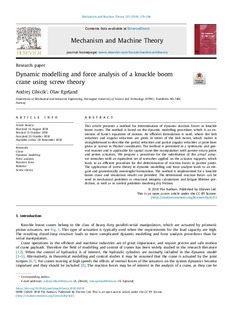| dc.contributor.author | Cibicik, Andrej | |
| dc.contributor.author | Egeland, Olav | |
| dc.date.accessioned | 2019-02-20T12:31:27Z | |
| dc.date.available | 2019-02-20T12:31:27Z | |
| dc.date.created | 2018-11-28T08:29:21Z | |
| dc.date.issued | 2018 | |
| dc.identifier.citation | Mechanism and machine theory. 2018, 133 179-194. | nb_NO |
| dc.identifier.issn | 0094-114X | |
| dc.identifier.uri | http://hdl.handle.net/11250/2586538 | |
| dc.description.abstract | This article presents a method for determination of dynamic reaction forces in knuckle boom cranes. The method is based on the dynamic modelling procedure, which is an extension of Kane’s equations of motion. An efficient formulation is used, where the link velocities and angular velocities are given in terms of the link twists, which makes it straightforward to describe the partial velocities and partial angular velocities as joint lines given as screws in Plücker coordinates. The method is presented in a systematic and general manner and is applicable for spatial crane-like manipulators with passive rotary joints and piston actuators. We propose a procedure for the substitution of the actual actuator wrenches with an equivalent set of wrenches applied on the actuator supports, which leads to an efficient procedure for the determination of reaction forces in passive joints. The application of screw theory to dynamic modelling and force analysis leads to an elegant and geometrically meaningful formulation. The method is implemented for a knuckle boom crane and simulation results are provided. The determined reaction forces can be used in mechanical problems as structural integrity calculations and fatigue lifetime prediction, as well as in control problems involving dry friction. | nb_NO |
| dc.language.iso | eng | nb_NO |
| dc.publisher | Elsevier | nb_NO |
| dc.rights | Navngivelse 4.0 Internasjonal | * |
| dc.rights.uri | http://creativecommons.org/licenses/by/4.0/deed.no | * |
| dc.title | Dynamic modelling and force analysis of a knuckle boom crane using screw theory | nb_NO |
| dc.title.alternative | Dynamic modelling and force analysis of a knuckle boom crane using screw theory | nb_NO |
| dc.type | Journal article | nb_NO |
| dc.type | Peer reviewed | nb_NO |
| dc.description.version | publishedVersion | nb_NO |
| dc.source.pagenumber | 179-194 | nb_NO |
| dc.source.volume | 133 | nb_NO |
| dc.source.journal | Mechanism and machine theory | nb_NO |
| dc.identifier.doi | https://doi.org/10.1016/j.mechmachtheory.2018.10.019 | |
| dc.identifier.cristin | 1636084 | |
| dc.description.localcode | © 2018 The Authors. Published by Elsevier Ltd. This is an open access article under the CC BY license.(http://creativecommons.org/licenses/by/4.0/) | nb_NO |
| cristin.unitcode | 194,64,92,0 | |
| cristin.unitname | Institutt for maskinteknikk og produksjon | |
| cristin.ispublished | true | |
| cristin.fulltext | postprint | |
| cristin.qualitycode | 1 | |

